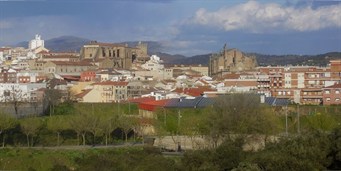Plasencia
 Plasencia, today part of the province of Cáceres, was founded in 1186 by Alfonso VIII of Castile who took it from territory under Muslim domination. Elected a diocese in 1188, Plasencia began a long period of economic expansion and population growth since the thirteenth century. In 1442 the city became a fief of the Zúñiga, who obtained it with the title of counts. Having a major role in the dynastic struggles that plagued fifteenth century Castile, Plasencia recovered its status as a free city in 1488 thanks to the support of the Catholic Monarchs, who thus escaped the domain of the Zúñiga. In 1515, Ferdinand II of Aragon came to spend the last months of his life in Plasencia, on the advice of doctors. After taking part in the revolt of the comuneros (1520-1521), the city experienced a prosperous period in the sixteenth century, during which they were built landmarks such as the Catedral Nueva, the aqueduct and the palace of the Marquis of Mirabel. The crisis of the seventeenth century, which extended throughout Castile, was due to wars, epidemics of the plague and also the expulsion of the Moriscos, which deprived the city of a significant part of its population. The main altarpiece of the Catedral Nueva, one of the first works of the Spanish Baroque dates from this period. During the War of the Spanish Succession (1701-1713) Plasencia was occupied by the troops of Charles of Habsburg until 1706.
Plasencia, today part of the province of Cáceres, was founded in 1186 by Alfonso VIII of Castile who took it from territory under Muslim domination. Elected a diocese in 1188, Plasencia began a long period of economic expansion and population growth since the thirteenth century. In 1442 the city became a fief of the Zúñiga, who obtained it with the title of counts. Having a major role in the dynastic struggles that plagued fifteenth century Castile, Plasencia recovered its status as a free city in 1488 thanks to the support of the Catholic Monarchs, who thus escaped the domain of the Zúñiga. In 1515, Ferdinand II of Aragon came to spend the last months of his life in Plasencia, on the advice of doctors. After taking part in the revolt of the comuneros (1520-1521), the city experienced a prosperous period in the sixteenth century, during which they were built landmarks such as the Catedral Nueva, the aqueduct and the palace of the Marquis of Mirabel. The crisis of the seventeenth century, which extended throughout Castile, was due to wars, epidemics of the plague and also the expulsion of the Moriscos, which deprived the city of a significant part of its population. The main altarpiece of the Catedral Nueva, one of the first works of the Spanish Baroque dates from this period. During the War of the Spanish Succession (1701-1713) Plasencia was occupied by the troops of Charles of Habsburg until 1706.
